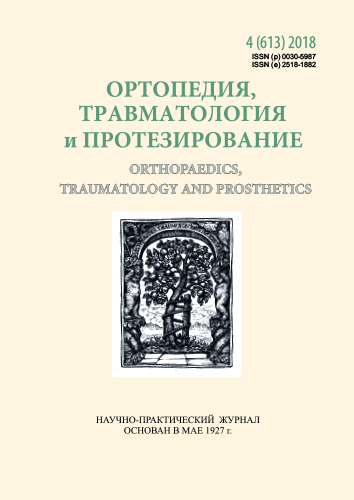Arthrodesis of ankle joint. Biomechanical aspects and algorithm of choice of methods of fixation
DOI:
https://doi.org/10.15674/0030-59872018464-70Keywords:
fusion of ankle joint, resection arthrodesis, foot position, fixation at arthrodesis, results of ankle joint arthrodesisAbstract
Objective: to improve the results of ankle joint arthrodesis by applying of biomechanical modification of the surgery technique and a differentiated approach to choice of methods of fixation. Methods: 348 patients (192 males, 156 females, middle age) were studied. Average age was (48.5 ± 3.8) years. In the main group (n1 = 176) modified method of arthrodesis of the ankle joint and differentiated approach for choosing means of fixation was applied, in the control group (n2 = 172) — t raditional m ethods of arthrodesis were used. Results: in the main group in 164 patients (93 %) the arthrodesis proved to be effective, the mean time
of bone fusion was (8.9 ± 0.4) weeks. In the control group bone fusion was observed in 138 patients (79 %) in (11.5 ± 0.9) weeks postoperatively. In (3.4 ± 1.8) years when we evaluated results
according to AOFAS in the main group, the average index for the posterior part of the foot was (78.2 ± 1.2) points, for the middle part — (81.3 ± 1.3), which corresponds to good functional results at absolute absence of motion in ankle joint. In the control group, the average index of AOFAS for the posterior part of the foot was (57.1 ±1.3) points, for the middle — (53.7 ± 1.4). In the main group compare to control group we
have revealed a decreasing in total time of foot weight bearing by 17.8 %, increasing in time of rolling over the heel (average (23.8 ± 0.8) %), reduction of time of rollover through the anterior part to (27.1 ± 1.2) % and moderate elevation of the interjoging period (49.1 ± 1.2) %. Decreasing of strength impulse of the vertical component in the main group (3608 ± 2.4) compare to the control group (3982 ± 3.6) indicated to decreasing in the energy intensity of walking when we used a modified resection technique for arthrodesis. Conclusions: modified method
for resection arthrodesis of ankle joint is shown to be better than traditional one. That is confirmed by functional, biomechanical
and X-ray studies.
References
- Hendrickx, R. P., Stufkens, S. A., De Bruijn, E. E., Sierevelt, I. N., Van Dijk, C. N., & Kerkhoffs, G. M. (2011). Medium- to long-term outcome of ankle arthrodesis. Foot & Ankle International, 32 (10), 940–947. doi:https://doi.org/10.3113/fai.2011.0940
- Hoover, J. R., Santrock, R. D., & James, W. C. (2011). Ankle fusion stability: a biomechanical comparison of external versus internal fixation. Orthopedics, 34 (4), 272. doi:https://doi.org/10.3928/01477447-20110228-04
- Akra, G. A., Middleton, A., Adedapo, A. O., Port, A., & Finn, P. (2010). Outcome of ankle arthrodesis using a transfibular approach. The Journal of Foot and Ankle Surgery, 49 (6), 508–512. doi:https://doi.org/10.1053/j.jfas.2010.07.004
- Lyabakh, A. P., Buryanov, O. A., Omelchenko, T. M., & Khomich, S. V. (2013). A method for resection arthrodesis of the ankle joint. Patent 84723 UA. (in Ukrainian)
- Richter, M., Evers, J., Waehnert, D., DeOrio, J. K., Pinzur, M., Schulze, M., … Ochman, S. (2014). Biomechanical comparison of stability of tibiotalocalcaneal arthrodesis with two different intramedullary retrograde nails. Foot and Ankle Surgery, 20 (1), 14–19. doi:https://doi.org/10.1016/j.fas.2013.08.003
- Thomas, R. L., Sathe, V., & Habib, S. I. (2012). The use of intramedullary nails in tibiotalocalcaneal arthrodesis. American Academy of Orthopaedic Surgeon, 20 (1), 1–7. doi:https://doi.org/10.5435/00124635-201201000-00001
- Lui, T. H. (2012). Tibiotalocalcaneal arthrodesis with combined retrograde intramedullary nail and lateral L-plate. The Journal of Foot and Ankle Surgery, 51 (5), 693–695. doi:https://doi.org/10.1053/j.jfas.2012.05.012
- Berkowitz, M. J., Clare, M. P., Walling, A. K., & Sanders, R. (2011). Salvage of failed total ankle arthroplasty with fusion using structural allograft and internal fixation. Foot & Ankle International, 32 (5), 493–502. doi:https://doi.org/10.3113/fai.2011.0493
- Nielsen, K. K., Linde, F., & Jensen, N. C. (2008). The outcome of arthroscopic and open surgery ankle arthrodesis. Foot and Ankle Surgery, 14 (3), 153–157. doi:https://doi.org/10.1016/j.fas.2008.01.003
- Stone, J. W. (2006). Arthroscopic ankle arthrodesis. Foot and Ankle Clinics, 11 (2), 361–368. doi: https://doi.org/10.1016/j.fcl.2006.03.007
- Cottino, U., Collo, G., Morino, L., Cosentino, A., Gallina, V., Deregibus, M., & Tellini, A. (2012). Arthroscopic ankle arthrodesis: a review. Current Reviews in Musculo¬skeletal Medicine, 5 (2), 151–155. doi: https://doi.org/10.1007/s12178-012-9119-x
- Ogut, T., Glisson, R. R., Chuckpaiwong, B., Le, I. L., & Easley, M. E. (2009). External ring fixation versus screw fixation for ankle arthrodesis: a biomechanical comparison. Foot & Ankle International, 30 (4), 353–360. doi:https://doi.org/10.3113/fai.2009.0353
Downloads
How to Cite
Issue
Section
License
Copyright (c) 2019 Taras Omelchenko, Oleksandr Buryanov, Andriy Lyabakh

This work is licensed under a Creative Commons Attribution 4.0 International License.
The authors retain the right of authorship of their manuscript and pass the journal the right of the first publication of this article, which automatically become available from the date of publication under the terms of Creative Commons Attribution License, which allows others to freely distribute the published manuscript with mandatory linking to authors of the original research and the first publication of this one in this journal.
Authors have the right to enter into a separate supplemental agreement on the additional non-exclusive distribution of manuscript in the form in which it was published by the journal (i.e. to put work in electronic storage of an institution or publish as a part of the book) while maintaining the reference to the first publication of the manuscript in this journal.
The editorial policy of the journal allows authors and encourages manuscript accommodation online (i.e. in storage of an institution or on the personal websites) as before submission of the manuscript to the editorial office, and during its editorial processing because it contributes to productive scientific discussion and positively affects the efficiency and dynamics of the published manuscript citation (see The Effect of Open Access).














